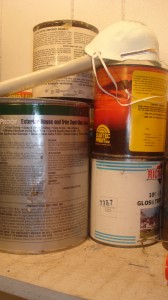So now the weather is cooling off and you’ve been thinking about doing something to give your home a much-needed facelift. Perhaps now you’re thinking you want to add some seasonal touches. The easiest way to spruce up a home is with a coat of paint. Painting will give the home an updated, refreshed look and the home will immediately seem more defined and welcoming.
The best time to paint the interior of a home is in the fall or spring. The cooler weather makes working both inside and out much more pleasant. Cooler weather also allows you to ventilate the rooms by opening up windows. When it comes to the job itself with so many paint choices, which one should you choose? Lead-based paints seem to have been eliminated from the US market, however, there are still other issues with paint that need addressing.
According to the Green Builders Coalition, all paint comes in three parts: pigment that gives it color; the binder, or resin, that makes the pigment stick when the paint is applied and forms a solid layer of paint; and the carrier, or solvent, that keeps the paint in liquid form and evaporates once the paint is exposed to air. All of these contain different chemicals. Other substances or chemicals may be added to paint to give it special characteristics, such as mold resistance or moisture resistance.
One additive besides lead that has received much attention recently is volatile organic compounds, or VOCs. Why are VOCs in paint in the first place? They are the “glue” that keeps the pigment and the binder or resin in a liquid solution long enough for the paint to be applied, then they conveniently evaporate so the paint can dry. Therefore, VOCs do serve a necessary function in paint.
Why is there a major concern over high-VOC paints? Like anything that produces high vapors, paints that have high-VOCs may cause or trigger respiratory problems. Consumers need to be aware that, although evaporation is greatest during and right after application, it may continue at lower levels for months. The emitted gases mix with the air in the room, exposing occupants to chemicals that can cause short- and long-term respiratory problems.
The solution is not to leave the house unpainted, but to find low- or no-VOC paints, which are now sold side-by-side with conventional high-VOC paints. Most home improvement stores carry these; consumers just have to do their homework. While there are no building code limitations on use of low-VOC paints, it is imperative that consumers find out more about the product before they select it. The EPA website, http://www.epa.gov/iaq/voc.html#Health_Effects, offers more information on VOCs in general. The National Association of Home Builders also has posted a guide consumers can use to select low-VOC paint on their website: http://www.toolbase.org/Technology-Inventory/Interior-Partitions-Ceilings/low-voc-paints.
Sprucing up your home can be very exciting and painting your home is a great way to express your individuality and ensure your home reflects your sense of style and personality. For more information on maintaining your home, visit the University of Florida/IFAS Extension publications website at http://edis.ifas.ufl.edu/topic_homes.
- 5 Easy Steps to Save for Big Ticket Items - August 29, 2015
- Student Loans: Do Your Homework Before You Borrow! - July 15, 2015
- Resolutions for Living Well - January 17, 2015

